Republished courtesy of the Australian Chess Federation
The 19th edition of the Bangkok Chess Club Open was held at the Centara Grand at Central Plaza Ladprao Hotel in Bangkok from 6-14 April. Two hundred and one players contested the nine-round “Open” tournament (including 13 Australians) whilst a further 103 players participated in the seven-round “Challenger” event (including another three Australians).
Thirty-nine nations were represented, their flags creating a colourful spectacle on each table throughout the well-appointed hotel ballroom.

The feature event was once again headlined by elite Grandmasters Nigel Short and Jan Gustafsson, who require no introduction to chess enthusiasts. A total of seventeen grandmasters were present, including six from India. Australia’s challenge was spearheaded by former winner GM Zong-Yuan Zhao and GM Moulthun Ly, with FM Tim Reilly and Colin Savige in support.

Round 1
Short began the tournament with a spectacular Rook and Queen sacrifice against Indian junior Ramesh Avinash.
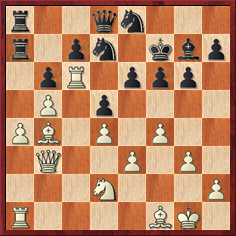
In this position, Short shocked his opponent with 29 Rxe6!! intending to answer …Kxe6 with 30 Qxd5+ with mate to follow.
GM Zong-Yuan Zhao began with a smooth win. The writer of these lines had the pleasure of a game with “The Quiet Assassin”, GM Moulthun Ly, and was duly asphyxiated without landing a punch.
Round 2
Leading players are often heard to bemoan how these days, there are few easy games. Engines have allowed all players to come to the board well armed, and a stronger player’s higher skill level may not be evident for a long time if he is caught in a prepared line. Upsets are becoming increasingly common. This phenomenon is particularly evident at the Bangkok Chess Club Open, which features high numbers of representatives from countries where ratings are not as reliable as in more established regions.
This was particularly so in the second round, when, despite a rating differential of approximately 500 points on each board, the favourites could only bring home the full point on 8 of the top 13 boards. The most dramatic of these upsets took place on the very top board, where local FM Poompong Wiwatanadate (ELO 2025) took on the top-seeded Short.
This clash was eagerly anticipated by connoisseurs of high fashion, as Poompong has long been recognised as the best-dressed chess player in South East Asia, and Nigel Short is also known for his stylish suits at the board.
Poompong arrived resplendent in a dark suit with his trademark tie in the colours of his national flag. Short, who had played this opponent twice previously and was alert to the danger of being outdressed, had collected a brand new suit from a Sukhumvit Road tailor on the previous evening, and so was able to fully counter any sartorial advantage his opponent might have hoped for.
While the two players were always expected to be well matched in terms of appearance, it was a surprise to see the Thai player also holding his own over the board in a hard-fought game. The contest became something of a free-for-all as the time control approached when firstly Short missed a winning line, and then the Thai player let his own winning opportunity slip by. A perpetual check soon resulted. A great result for Thailand chess!
A second upset brought great cheer to Australian observers when Colin Savige, who had played very well to arrive at a fully equal ending with Indian GM Dhopade Swapnil , received an unexpected bonus half point when the latter failed to make a move in time.
Notable among other upsets was 13 years old Filipino junior Nouri Alekhine holding Indian GM Babu Lalith to a draw and Tournament Director IO Kai Tuorila sharing the point with GM Dibyendu Barua.
Amid the mayhem, the two Australian Grandmasters safely progressed to 2/2, as did the second-seeded Gustafsson, who now assumed the mantle of tournament favourite.
Round 3
Short showed that his misfortune of the previous day had not affected his sense of humour after being paired with the dangerous Nouri Alekhine for round 3, tweeting the following:
“It is a bit disconcerting, after the debacle of yesterday, to find myself facing Alekhine in the third round. I had been labouring under the misapprehension that he died in Estoril in 1946”.
As it turned out, the English Grandmaster need not have been too worried, overcoming the determined resistance of his young opponent with some fine sacrificial play.

White has built up a sizeable advantage, but how can he break through?
37 Nxg6! fxg6 38 Re6!
Beautifully played! White takes advantage of firstly a pin and then a fork to destroy all communication between Black’s Queen and bishop. Now the Black Queen is completely cut off from the action on the kingside.
38…Nf6
39 Bxf5 gxf5
40 h5 Nxe6
41 dxe6
1-0
Jan Gustafsson won his third straight game, and the two Australian GM’s also progressed to perfect scores.
Indian Grandmaster Deep Sengupta showed he too was in fine form when he produced the most spectacular of several dramatic Queen sacrifices in this tournament against his compatriot WIM V Varshini:

Sengupta produced a real “bolt from the blue” with 23…Qh3!! which must have left his opponent thinking “where did THAT come from?”. White was able to defend with 24 Nf3 but after …Bxf3 25 gxf3 Nf5 the initiative had passed to Black who duly won to join the leaders.
Round 4
Short continued his renaissance by defeating the American John Langreck, while Gustafsson also won against his countryman, Pattaya resident GM Gerhard Schebler, to become the only player to have won all four games.
Both Australians were held to a draw in this round. Moulthun’s game was particularly interesting:
GM Moulthun Ly (2490)-Saha Neelash (2302)
1 d4 Nf6
2 c4 c5
3 d5 e6
4 Nc3 exd5
5 cxd5 d6
6 Nf3 g6
7 h3
A key difference between the King’s Indian defence and the Benoni is the value of Black’s light-squared bishop. In the King’s Indian, he is a vital support to the standard kingside pawn storm, often sitting contentedly on d7 for a long time before spectacularly sacrificing himself on h3 to smash open the White King’s defences. In the Benoni, however, Black is more likely to advance his queenside pawns than his kingside ones. His light squared bishop struggles to find a good square, as d7 is an important travelling route for the Benoni knights. Therefore, Black is usually keen to exchange his problem bishop by a timely …Bg4. Moulthun prevents this.
7…Bg7
8 e4 0-0
9 Bd3 Nbd7
10 0-0 Ne8
11 Bg5 f6
12 Be3 Ne5
13 Nxe5 fxe5
White has an edge in the form of his more flexible dark-squared bishop and more space. Black’s dark-squared bishop is very passive at present and will struggle to participate in any action that might occur on the queenside. Moulthun immediately initiates play there.
14 Rb1 Bd7
15 b4! Qc8
16 bxc5 dxc5
17 Bb5!
Black’s light-squared bishop did manage to become a good piece in this game, but Moulthun easily exchanges his own problem bishop for it, leaving him with the clearly superior bishop.
17… Bxb5
18 Nxb5 a6
When faced with such a move, a lower rated player instinctively starts looking at where to retreat his knight. A master’s mind is more flexible at such moments and does not forget that even a threat to win a piece can be effectively met by an equal or stronger threat…
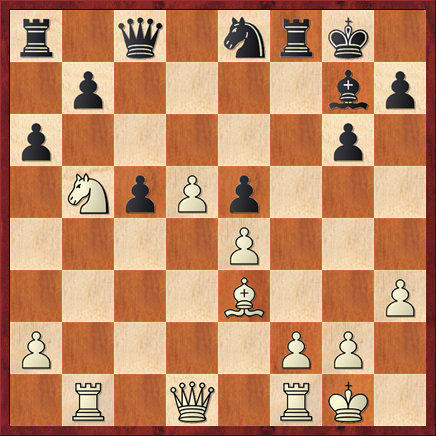
19 d6!? axb5
20 d7 Qc6
If 20…Qc7 then White checks on d5, takes on e8 and then takes on c5 with a winning game.
21 d8 (Q) Rxd8
22 Qxd8 Nd6
23 Qe7?!
The Queen was better placed on the queenside where it could harass Black’s pawns there. White’s prospects after 23 Qa5! are superior, but now Black’s position is the easier to play.
23….Re8
24 Qh4 Nxe4
25 Rbc1?!
Difficult to find was 25 Rxb5! Qxb5 (the attempted zwischenzug 25…Bf6 26 Qg4 changes nothing) 26 Qxe4 and the threat of Rb1 will result in the fall of one of Black’s queenside pawns, ensuring at least equality for White.
After the move played in the game, White must defend carefully, as Black can establish a minor piece on d4 and look to advance his queenside pawns.
25…b6
26 Bh6 Bf6
27 Qg4 Nd6
28 Rcd1 Nf5
29 Be3 e4
30 Rd2 Bc3
31 Rc2 Bd4
32 Bxd4 Nxd4
33 Rd2 Qd5
Threatening …Nf3+.
34 Kh1 Kg7
35 Re1 Re7
36 Re3 Qc4?!
Black has maintained his advantage, his two extra pawns and strong knight more than compensating for his exchange deficit. But the move played allows an immediate draw. It is unclear whether Black saw White’s next and was content to draw with a Grandmaster, or whether the move played was simply an oversight with the time control approaching.
37 Rxe4!
For the second time in this game, Moulthun is able to meet a threat with an equal or stronger one of his own.
37…Rxe4
A perpetual check will follow 38 Qxe4 Qc1+ 39 Kh2 Qxd2 40 Qe7+.
1/2-1/2
Round 5
Another win for Short, this time against Indian GM Abhijit Kunte. The Australians slipped a little off the pace, with Zhao agreeing to a quick draw with another Indian GM, Jha Sriram, while Moulthun suffered a loss to Indonesian FM Andrean Susilodinata.
Meanwhile, Gustafsson decided that it was not enough simply to be ahead of his English rival on points…he also wanted to draw level with him in spectacular Queen sacrifices.
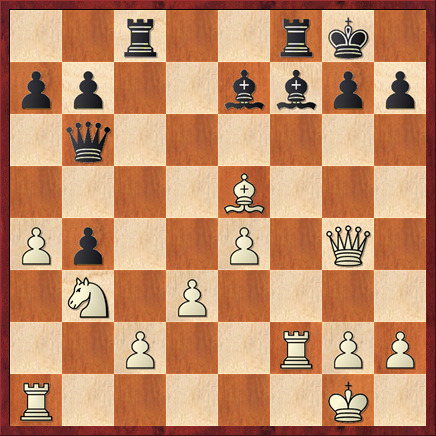
In Venkataraman-Gustafsson, White had been doing well before his fatal last move, blocking the Queen’s check with 23 Rf2. He immediately resigned on seeing the reply …Qxf2+!
Round 6
Gustafsson was finally held to a draw, the feat being achieved by Lalith. Short caught the leader by defeating Moulthun’s conqueror from the previous round.

Moulthun bounced back with a win, whilst Zhao caught the “Queen sacrifice fever” which was so virulent on the top boards this year and defeated Pia Cramling’s husband in fine style.
GM Zong-Yuan Zhao (2529)-GM Juan Bellon Lopez (2343)
1 e4 c5
2 Nf3 e6
3 d4 cxd4
4 Nxd4 Nc6
5 Nc3 Qc7
6 Be3 Nf6
7 f4 d6
8 Qf3 a6
9 0-0-0 h5
10 e5 Nxd4?!
Black plans to offer an exchange of Queens, but the move played merely develops White’s game.
11 Bxd4 dxe5
12 Bxe5 Qc6
13 Qd3 Bd7
14 Be2! Rd8
Of course not 14…Qxg2 as White will then “remove the guard” by taking firstly on f6 and then on d7 with mate.
15 Bf3 Qb6
16 Ne4 Nd5
17 Rhe1 Qa5

18 Qxd5!
A spectacular way to take advantage of the Black King never leaving the centre.
18…Qxe1
After 18…exd5 19 Nf6+! gxf6 20 Bc3+ and whichever bishop blocks the check will be vulnerable to a pin, giving Black’s Rook no time to flee after Bxa5.
Also losing is 18….Qxd5 19 Rxd5 exd5 20 Nf6+! gxf6 21 Bxf6+ and 22 Bxh8.
19 Qd4 Qh4
Murderous is 19…Qa5 20 Bxg7 Bxg7 21 Qxg7 Rf8 22 Nd6+ Ke7 23 f5.
20 g3 Qe7
21 Nf6+
White would win even more material with 21 Nd6+, but the move played also induced immediate surrender.
1-0
Round 7
The long-awaited showdown arrived between the two elite GMs, who shared the lead alone, each having conceded just the one draw. Those who hoped for a keen contest were not disappointed.

GM Nigel Short (2636)-GM Jan Gustafsson (2633)
1 d4 Nf6
2 Nf3 d5
3 c4 e6
4 Nc3 dxc4
5 e4 Bb4
6 Bg5 c5
7 Bxc4 cxd4
8 Nxd4 Bxc3+
9 bxc3 Qa5
10 Bxf6 Qxc3+
11 Kf1 gxf6
A rare instance where taking a piece with check is bad! After 11 …Qxc4+?! 12 Kg1 the threat of Rc1 means Black will not get to capture the bishop on f6.
12 Rc1 Qa5
A sharp opening. Black has a pawn but his King is unsafe.
This position was seen in Bu-Piorun at the Batumi Olympiad last year. The Chinese player proceeded with 13 Qg4 eyeing an invasion of g7 by the Queen. Short prefers to bring his King’s Rook quickly into the game and to attack directly along the central files.
13 g3
Black must now choose whether to castle or hide his King behind his central pawns. Gustafsson was critical of his choice after the game, explaining that he was familiar with this position and that he knew that Black is supposed to be fine after castling. However, during the game, he preferred e7 for the King so that after Black pins White’s knight to his Queen with …Rd8, the pin cannot be simply broken by Qg4+.
However, the King is at risk in the centre of the board, as Short proceeds to demonstrate.
13…Ke7
14 Kg2 Rd8
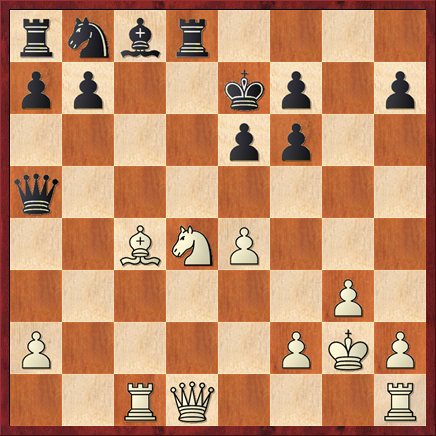
15 Nf5+! exf5
After 15…Kf8 16 Qh5 wins immediately.
16 Qh5 Rf8
White clearly has at least a draw after 16…Be6 17 Bxe6 fxe6 18 Qxh7+
Engines now suggest the surprising pawn grab 17 Bxf7, the point of which is of course not to collect a pawn, but to clear the seventh rank so that a later Qh7+ will carry a lot of punch.
Short prefers the logical and consistent “human” move in this position, bringing his least active piece into his attack.
17 Rhe1 Nc6
It is much easier to annotate than to play. Engines have pointed out the somewhat superior defence 17…Bd7 with a small advantage to Black, the point being that after 18 exf5+ the Black King can now go to d8 despite the lack of communication between his Rooks because 19 Qh6 is efficiently met by …Bc6 with a key tempo gaining check, followed by …Nd7, protecting both f8 and f6.
18 exf5+ Kd6
Now …Kd8 was not possible, as 19 Qh6 would be a winning double attack against f8 and f6.
19 Qh6 Bd7
Had the King been on d8, this move would not have connected the two Rooks.
20 Qf4+ Ne5
21 Qd4+ Ke7
22 Bd5!
Interfering with the Queen’s defence of e5. A drawing sacrifice on that square now cannot be prevented.
22… Rfd8
23 Rxe5+ fxe5
24 Qxe5+ Kf8
25 Qh8+ Ke7
26 Qe5+ Kf8
27 Qh8+
1/2-1/2
A high-class encounter.
Meanwhile, the Australian challenge was set back when Zhao suffered his first defeat on board 4 to Vietnamese IM The Anh Duong (who now caught the two leaders) and Moulthun could only draw with Indian IM Subbaraman Vijayalakshmi on board 6.
Round 8
This turned out to be the decisive round of the tournament.
Gustafsson efficiently halted the charge of Duong, whilst Short, who had sacrificed a piece in almost every game so far, did so once too often against Kunte and lost.
Zhao bounced back with a very fine win over Filipino Louie Salvador, the recent winner of the Laos Open, achieving a near zugzwang with many pieces still on the board:
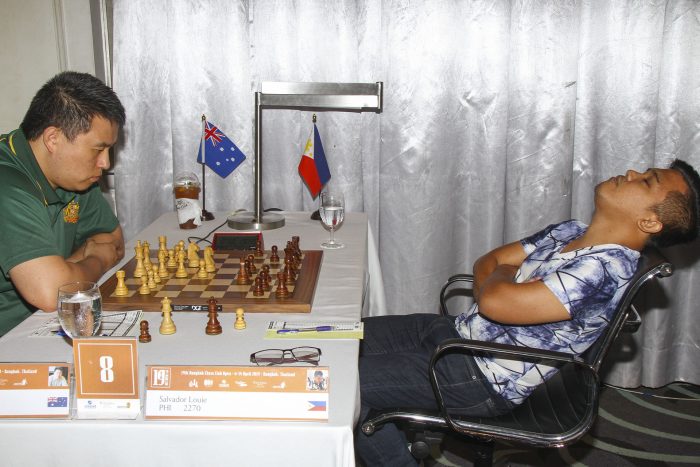
GM Zong-Yuan Zhao (2529)-Louie Salvador (2270)
1 e4 c5
2 Nf3 d6
3 d4 cxd4
4 Nxd4 Nf6
5 Nc3 a6
6 Be3 e6
7 Be2 Be7
8 f4 Qc7
9 g4 b5
10 g5 Nfd7
11 a3 Bb7
12 f5 e5
13 Nb3 Nc5?!
Black misses a chance to break up White’s threatening pawns by taking advantage of the White King also being in the centre. After 13…h6! 14 gxh6 Bh4+ 15 Kf1 gxh6 there would be chances for both sides.
14 Nd5 Bxd5
15 Qxd5 Qc6
16 Nxc5 Qxd5
17 exd5 dxc5
18 a4 b4
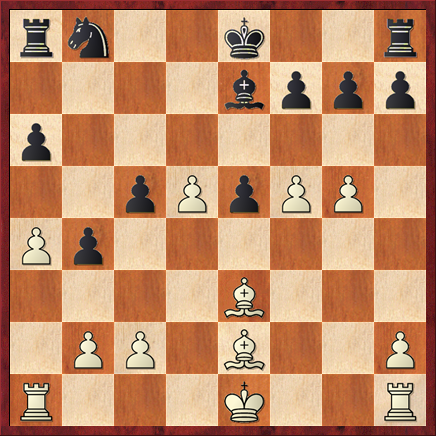
19 d6!
Opening the game for the two bishops. The light-squared one now becomes an unopposed monster.
19…Bxd6
20 0-0-0 Be7
21 f6 gxf6
22 gxf6 Bxf6
If 22…Bf8, 23 Rd5 regains the pawn with huge interest.
23 Bf3 Ra7
24 Bxc5 Rd7
25 Bd6 Rd8
26 Rhg1 h6
27 Kb1!
White has noticed that Black is helpless. His pieces are very close to zugzwang. Almost any move by a piece will lose material, and pawn moves will soon run out.
27…h5
If 27…Nd7 28 Bc6 (threatening Bc7) Rc8 29 Bb7 Rd8 30 Bc7 wins.
Black is reduced to making harmless moves with his Queen’s Rook. Any other move by a piece loses material immediately.
28 a5 Rc8
29 Bb7 Rd8
30 Ka2 Rxd6
Equivalent to resignation, but 30 …Rd7 31 Be4 Rd8 32 Kb3! Rc8 33 Bxb8 Rxb8 34 Rd6 followed by Rxa6 also wins comfortably, as White retains a powerful attack.
31 Rxd6 Be7
32 Rd5 f6
33 c4 bxc3
34 bxc3 Kf7
35 c4 Ke6
36 Rgd1 Rg8
37 Kb3 e4
38 c5 e3
39 Rxh5 e2
40 Re1
1-0
A masterful display of paralysis!
Meanwhile, Moulthun was held to a draw by WIM Varshini.
Scoring was as follows with one round to play:
Gustafsson 7, Sengupta, Pascua, Lalith 6.5, Short, Zhao and Kunte were among an eleven-way tie for 5th on 6/8, while Moulthun had half a point less.
Round 9
Gustafsson took a quick draw against Savige’s victim Swapnil, trusting that his tiebreak tally (the combined scores of all of one’s opponents) would hold up against any of his pursuers should they win. His judgment proved to be sound, as Sengupta (the only winner of the three) needed his opponents to score two more points than they managed. The title, therefore, went for the second time to Jan Gustafsson, who did his reputation in Bangkok no harm with his declaration at the prize-giving ceremony that the Bangkok Chess Club Open “is arguably the best tournament in the world”.

Sengupta, while narrowly missing out on the title, shared first and second prize money of 170,000 baht [AUD $7,500] with the winner.
Zong-Yuan defeated Kunte to advance into a tie for third place on 7/9, and Moulthun also won to finish on 6.5/9 and ensure a healthy cheque, sharing seventh place with (among others) Nigel Short.
Of the other Australians, positive ELO performances were achieved by the following Open players:
- Rebecca Stones 5.5/9
- Colin Savige 5/9
- Ben Atia 4/9
- Raphael Atia 3/9
- Jordan Chan 2.5/9
Particularly impressive were the performances of the Atia siblings, who added a combined 210 ELO points. We would like to know what their mother is cooking for their dinners.
Leading scores:
| 1 | GM | Gustafsson Jan | GER | 2633 | 7,5 |
| 2 | GM | Sengupta Deep | IND | 2551 | 7,5 |
| 3-6 | GM | Karthik Venkataraman | IND | 2505 | 7,0 |
| 3-6 | GM | Zhao Zong-Yuan | AUS | 2529 | 7,0 |
| 3-6 | GM | Swapnil S. Dhopade | IND | 2488 | 7,0 |
| 3-6 | GM | Stella Andrea | ITA | 2512 | 7,0 |
Full results may be found here.
The Challenger Tournament
Filipino Ric Portugalera triumphed in the Challenger tournament, his 6/7 prevailing on countback over three other players on the same score, including Thailand’s Theemathas Chirananthavat, who impressed after a lengthy period away from tournament activity.
Of the Australians, David Lovejoy played solidly to achieve 5/7 (including a loss to the winner) to enhance his ELO rating. Myiesha Maunders and Melbourne Chess Club’s Elizabeth Warren scored four and two points respectively.
Next Year

Any Australians reading this report and contemplating participating in the 20th Open in 2020 can be assured of a warm reception to the premier chess tournament in South East Asia (or perhaps the world, as the winner suggested!) Usually, the tournament alternates each year between Bangkok and a seaside resort, which suggests that those who do come next year should pack their bathers.
We hope to welcome you to the Land of Smiles in 2020!
___________________________________
About the Author
Peter Frost is an Australian residing in Bangkok and a member of the host Bangkok Chess Club.
